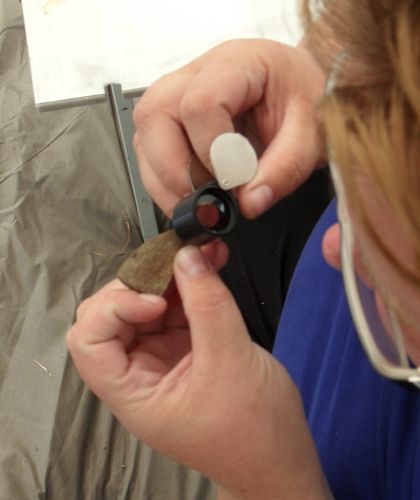Forget Las Vegas, Miami and New York – The real crime scene investigations are going on here at Stolbevaya. Each day we carry our shovels, screens, core sampler and a myriad of other helpful tools to try to piece together what happened here thousands of years ago. Like any good investigator we gather a lot of data and bag and tag a lot of evidence.
Back at the work tent, a veritable lab station, we have Rebecca Miller working to examine and catalog all of these artifacts. She cleans them, dries them bags them and labels them. She also takes photographs of the samples for publication later. What makes her qualified for this undertaking? Rebecca has a Bachelor's of Arts degree in Anthropology from University of Pittsburg and is currently in her second year of pursuing a Doctoral degree from State University of New York, Buffalo in Anthropology with a focus on Archeology.
 Rebecca uses a bucket of water and sponge to clean each artifact. At the lab sometimes acids are used to remove residue. This makes it easier to determine how the tools were used.
Rebecca uses a bucket of water and sponge to clean each artifact. At the lab sometimes acids are used to remove residue. This makes it easier to determine how the tools were used.
Her main interest is lithics, which is essentially the study of stone tools. She has a curiosity about where people get the materials in order to make their tools. Most of the time prehistoric people make their tools out of material that is readily available. However, there are times when we find an artifact that is made of material that does not occur naturally here on Kamchatka. For example, we have found obsidian flakes, chips that come off when they make a stone tool. Obsidian is not found naturally from the volcanoes in this region, so the question is 'Where does this material come from and how did the people here acquire it?' This is one of the questions she will focus on as she develops her thesis for her doctoral degree.
Now for the lab work, Rebecca uses a hand lens here in the field to get an up close and nosey look at the artifacts we find. When she is back at SUNY Buffalo, she has the advantage of using a microscope to see the edges of the stone tools. This information allows her to make educated guesses as to what tools were used for. Different materials leave different patterns on the tools. For example, she can tell if the tool was used for cutting wood, bone or softer materials.
 When a microscope is not available Rebecca can use a hand lens to examine the edges of tools to determine their uses.
When a microscope is not available Rebecca can use a hand lens to examine the edges of tools to determine their uses.
As a further indication that she is serious about this interest, Rebecca completed a project this year where she made her own tools out of obsidian and used them to and used them to cut, saw and drill through beef and chicken bones and hard and soft wood to determine patterns. It's like the CSI team doing ballistics tests to find the weapon that was used in a crime or what material the weapon may have been in contact with. I don't think she's looking to solve any prehistoric crimes but it does give us a lot of information about how the people lived, what they hunted and ate and what they made with the tools they had.
That said, it becomes very clear as you spend some time talking with Rebecca that her love of anthropology, the study of living cultures, and her interest in archeology, the study of past cultures, goes hand in hand. The link here is the tools, which when you look at them with the depth of knowledge she has acquired tell a lot about people both living and prehistoric. There are stories in the stones here, Rebecca's job is to be the interpreter.
 Greg's survey team brought back this complete projectile point from one of his test pits. It is a really nice example of a prehistoric tool.
Greg's survey team brought back this complete projectile point from one of his test pits. It is a really nice example of a prehistoric tool.
 This tiny projectile point was found at the first site we mapped on our first day of survey. We are not sure of its use, perhaps it was for practice or for showing off tool making skills.
This tiny projectile point was found at the first site we mapped on our first day of survey. We are not sure of its use, perhaps it was for practice or for showing off tool making skills.
